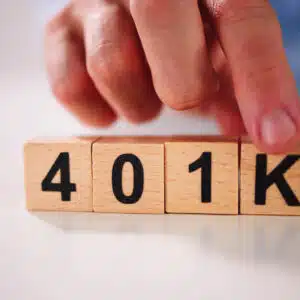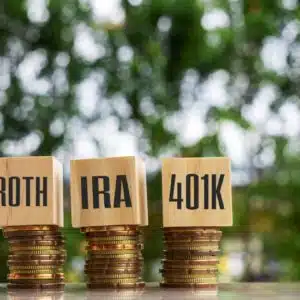When I worked for my old brokerage firm, I was a W-2 employee, and the retirement plan options were simple. I had the 401(k) and could also do a Traditional or Roth IRA outside of it. Things changed a bit when I started my own company.
I officially became a small business owner and had many more choices in retirement plans. What options do hands-on owner-operators have, and which one is the best for you? If you have a small company and want a retirement program, you want to consider these plan choices.
Table of Contents
Traditional or Roth IRA
I know what you’re thinking. A traditional or Roth IRA isn’t exactly a “business retirement plan.” But, if you are self-employed or own a business, you can still take advantage of these retirement accounts. An IRA is an Individual Retirement Account and can be a great way to save for retirement while also taking advantage of tax benefits.
There are two types of IRAs: traditional and Roth. With a traditional IRA, you will make your contributions with pre-tax dollars, reducing your taxable income for the year. The money will then grow tax-free until you withdraw it in retirement, at which point all of the withdrawals are taxed as ordinary income. With a Roth IRA, you will make contributions with after-tax dollars (reducing your take-home pay). The money will still grow tax-free until you withdraw it in retirement, but the difference is that all of your withdrawals are tax-free.
With either type of IRA, there are contribution limits and other rules you should be aware of before setting up an account. It’s also important to do research on different providers so you can find an IRA with low fees and good investment options.
| FEATURE | ROTH IRA | TRADITIONAL IRA |
|---|---|---|
| Tax Treatment | Contributions Are Made With After-Tax Dollars and Grow Tax-Free. Distributions in Retirement Are Tax-Free | Contributions Are Made With After-Tax Dollars and Grow Tax-Free. Distributions in Retirement Are Tax-Free |
| Income Limits | Contributions Are Made With Pre-tax Dollars, Reducing Your Taxable Income. Distributions in Retirement Are Taxed as Ordinary Income | There Are No Income Limits for Contributions, but There Are Limits on Tax Deductions Based on Income and Participation in an Employer-Sponsored Retirement Plan |
| Required Minimum Distributions | Roth IRAs Do Not Have Required Minimum Distributions (RMDs) During the Account Owner’s Lifetime | Traditional IRAs Have RMDs Starting at Age 73, Which Require the Account Owner to Take a Certain Amount of Money Out of the Account Each Year |
| Early Withdrawals | Contributions Are Limited Based on Income. In 2024, the Phase-Out Range for Single Filers Is $146,000–$161,000, and for Married Filers Is $230,000–$240,000 | Early Withdrawals Before Age 59 1/2 May Be Subject to a 10% Penalty in Addition to Income Taxes |
| Contribution Limits | In 2024, the Contribution Limit Is $7,000 per Year ($8,000 for Those Aged 50 or Older) | In 2024, the Contribution Limit Is $7,000 per Year ($8,000 for Those Aged 50 or Older) |
The SIMPLE IRA
These plans are very easy to create, and they have very low administrative costs and no annual IRS reporting requirements. You set up traditional IRAs for each eligible employee; they can contribute to the IRA on a tax-deferred basis (via payroll deductions, and you can either match the contributions of plan participants or contribute a fixed percentage of all eligible employees’ pay. The employees own the money in their IRAs.
I had considered going with the SIMPLE IRA initially, but the one item I didn’t like is that it has a 25% early withdrawal penalty for the first two years. This is well over the standard 10% all other plans have. In the event I did get into a bind, I didn’t like the idea of having to pay the extra to get it out.
The SEP IRA
A Simplified Employee Pension Plan lets you make contributions toward your retirement and your employees’ retirement. (You can even have a SEP and another kind of retirement plan at your business simultaneously.) A SEP allows business owners annual tax-deductible contributions equal to 25% of their compensation (if you have a corporation) or 20% of self-employment income (for a sole proprietor).
This is currently what I have and should satisfy me for a few more years. I even opened up two separate accounts so I could invest with Betterment and another where I control my own investments. Pretty soon, I hope to graduate to the next level…
The Solo 401(k)
Are you ready to fly solo? As in a “Solo” 401(k). Yes, you can have a 401(k) when you are self-employed. A business owner may establish one and include their spouse in the plan, provided the spouse is an employee of the business. A solo 401(k) throws in a profit-sharing twist on the standard 401(k). Solo 401ks may be funded by the employee (deferred compensation) and the business (a percentage of profit).
As an employee of your business, you can contribute an amount up to the standard yearly 401(k) contribution limit (catch-up contributions permissible if you are 50 or older). Additionally, solo 401(k) plans allow you to make tax-deductible profit-sharing contributions equal to 25% of your compensation (corporate entity) or 20% of self-employment income (sole proprietor). It is even possible to have a solo Roth 401(k). These plans do require a TPA (third-party administrator).
Ultimately, the Solo 401(k) will allow me to contribute the most pre-tax, but my income has to get me there first 🙂
Profit-Sharing Plans
Here’s one way to compete with larger companies for prime employees. Contributions are usually deductible at both the federal and state levels, with contribution limits equivalent to a SEP. Contributions aren’t mandatory. If your business has a bad year, you don’t have to make them. The assets placed within the plan grow tax-deferred. Again, annual tax-deductible contributions may be made according to the 25%/20% rule, depending on your business entity.
New Comparability Plans
Basically, this is a form of profit-sharing plan that rewards senior or key employees more than others. The classic situation for this plan is when you have a small business whose multiple owners take home similar earnings but are of different ages. The plan must be tested to meet Internal Revenue Code nondiscrimination requirements, of course. It allows different levels of compensation to different groups within a small business.
| PLAN TYPE | DESCRIPTION | CONTRIBUTION LIMITS | EMPLOYER CONTRIBUTIONS | EMPLOYEE CONTRIBUTIONS | ELIGIBILITY REQUIREMENTS |
|---|---|---|---|---|---|
| 401(k) plan | An Employer-Sponsored Retirement Plan That Allows Employees to Save for Retirement on a Pre-Tax or After-Tax Basis | $23,000 per Year (2024), With Catch-up Contributions Allowed for Those Over 50 | Employers Can Choose to Match Employee Contributions up to a Certain Amount or Make a Profit-Sharing Contribution | Employee Contributions Can Be Made on a Pre-tax or After-Tax Basis | Available to Any Business, Including Self-Employed Individuals |
| Traditional IRA | An Individual Retirement Account That Allows Individuals to Save for Retirement on a Pre-Tax Basis | $7,000 per Year (2024), With Catch-up Contributions Allowed for Those Over 50 | None, but Some Employers May Offer a SIMPLE IRA Option for Employees | Contributions Are Made by the Individual | Available to Anyone Under Age 73 Who Has Earned Income |
| Roth IRA | An Individual Retirement Account That Allows Individuals to Save for Retirement on a Pre-Tax Basis | $7,000 per Year (2024), With Catch-up Contributions Allowed for Those Over 50 | None, but Some Employers May Offer a SIMPLE IRA Option for Employees | Contributions Are Made by the Individual | Available to Anyone With Earned Income Below a Certain Threshold |
| SEP IRA | A Simplified Employee Pension Plan That Allows Employers to Make Tax-Deductible Contributions to a Traditional IRA for Each Eligible Employee | The Lesser of $69,000 or 25% Of Employee Compensation for the Year | Contributions Are Made by the Employer | None, but Employees Can Contribute to a Traditional IRA Outside of the SEP Plan | Available to Any Business, Including Self-Employed Individuals |
| SIMPLE IRA | A Savings Incentive Match Plan for Employees That Allows Employers and Employees to Make Contributions to a Traditional IRA | $16,000 per Year (2024), With Catch-up Contributions Allowed for Those Over 50 | Employers Can Choose to Match Employee Contributions up to a Certain Amount or Make a Non-elective Contribution | Contributions Are Made by the Employee | Available to Businesses With 100 or Fewer Employees |
| Defined Benefit Plan | A Retirement Plan That Provides a Specific Benefit Amount at Retirement Based on Factors Such as Salary and Years of Service | Contributions Are Determined by an Actuary Based on Funding Requirements | Contributions Are Made by the Employer | None, but Employees May Be Required to Meet Certain Eligibility Requirements, Such as a Certain Length of Service | Generally Available to Larger Businesses With the Ability to Fund Ongoing Plan Obligations |
What Plan Is Best for Your Business?
If you are reading this, you are probably thinking about putting a plan into place or switching to a retirement program that is more easily administered than the one you have now. But which one should you choose – and what is the next step? Take a big step today and take advantage of all that is available in the marketplace – consult an independent financial professional and a CPA to review your options and find the program that fits your needs.
The Bottom Line – Best Retirement Plan For Small Businesses
Navigating the myriad of retirement plan options for small businesses can be daunting, but the rewards of a well-chosen plan are manifold.
From the simplicity of Traditional and Roth IRAs to the flexibility of SEP IRAs and the power of Solo 401(k)s, there’s a solution tailored for every business size and type.
Whether you’re self-employed or manage a team, ensuring a secure retirement for both you and your employees is paramount.
To make the most informed decision, team up with an independent financial professional and a CPA. Together, you can explore and select the retirement program that aligns perfectly with your business’s unique needs.








I’m in unique situation owning 3 separate C Corps 100% of which 2 are with 1 accountant I inherited when I purchased and the 3rd with another accountant and it was my original business I set up with a 401K Rollover with strict IRS/DOL requirements. Unfortunately I’m not sure how to begin saving larger sums of money in the most tax efficient way. The 2nd business has roughly 10 employees so that is a lot of matching for an SEP IRA. The 3rd only has 4 employees but has the most debt and least income available to save and my original business is restricted by many rules. I can have a 401K there but it has strict requirements for all employees so I’m in a quandary on what to do. Any thoughts on how to unravel that mess? I’m hoping to unwind the 401K Rollover sooner than later which will alleviate some problems. Thanks for any advice.
I switched Plan administrators to Steidle Pension Solutions a few years ago and am extremely happy with their service. Whenever I call, a representative familiar with my Plan and business helps me…never an automated phone system ! They make the administration of my small business Plan easy and much more affordable. www.sps401k.com